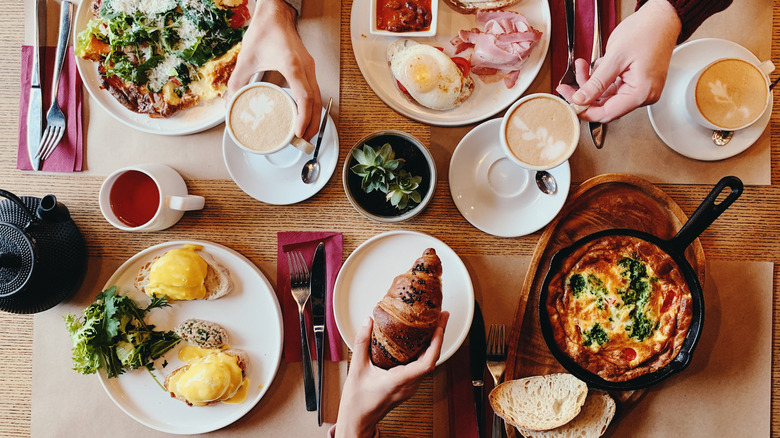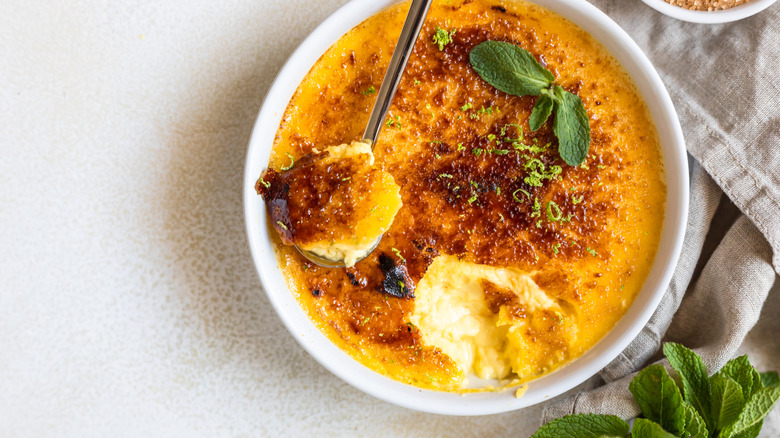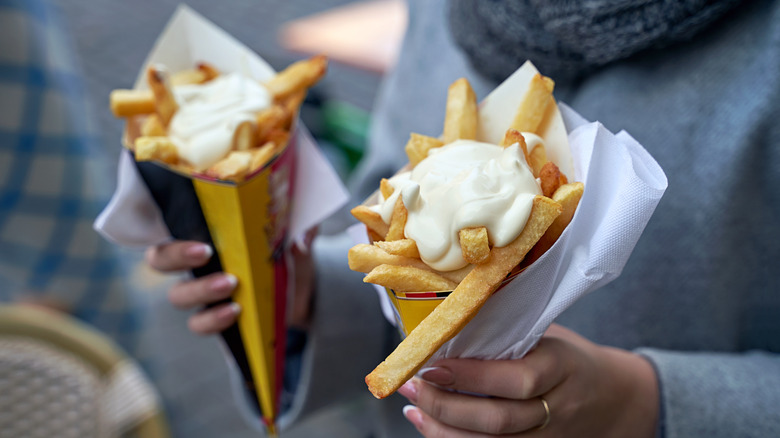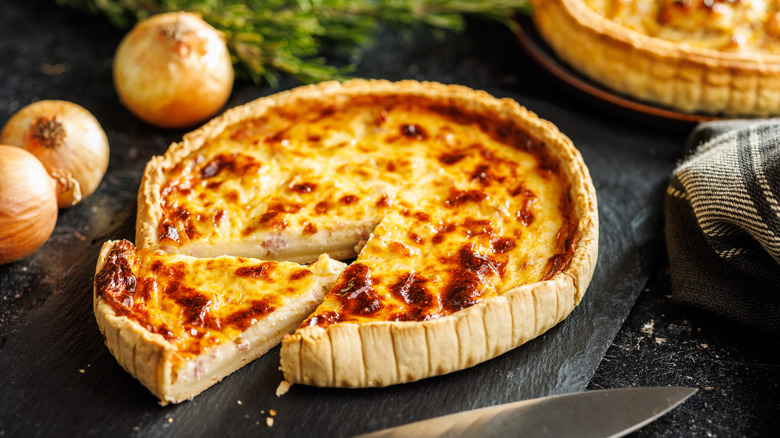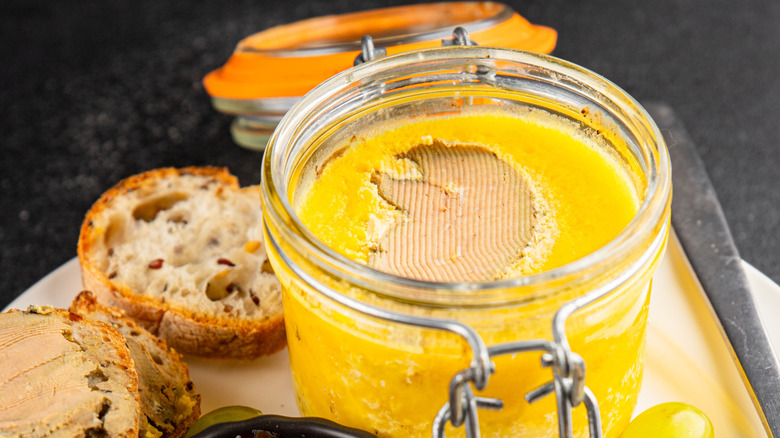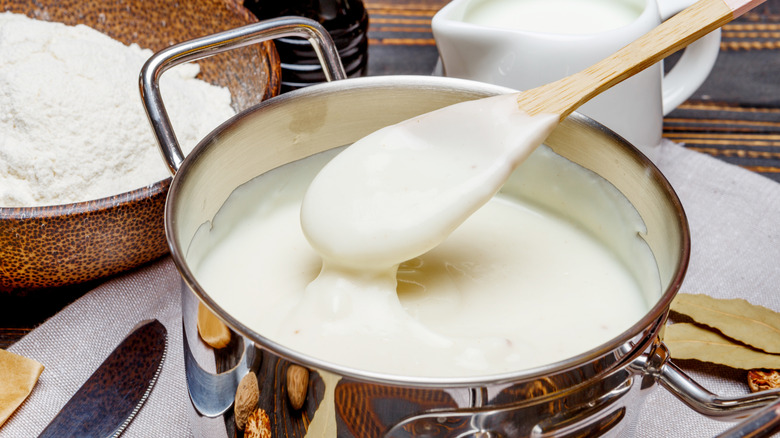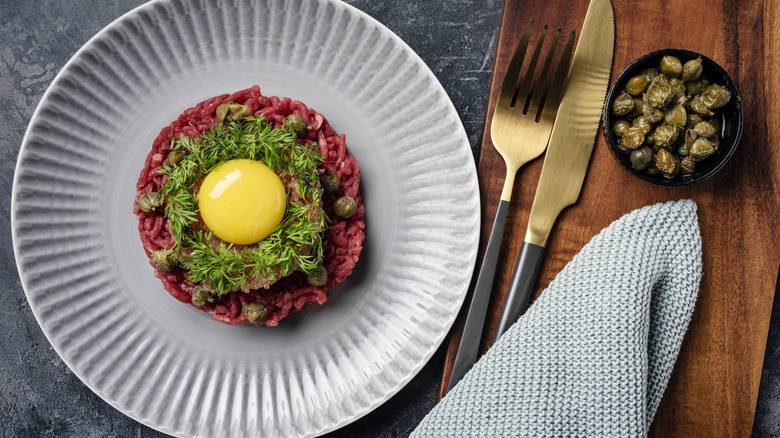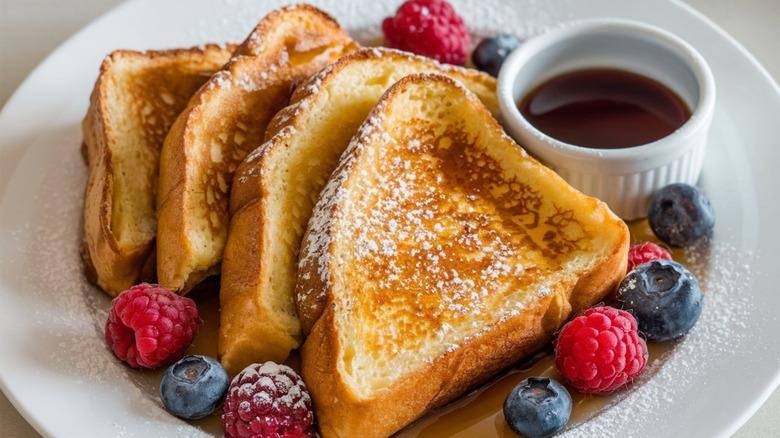11 French Specialties That Weren't Always French
Food is often one of the first associations people make with French culture. France is a country renowned for its gastronomy. Its crisp baguettes, omnipresent wine, and ample butter are cultural icons as much as they are culinary staples. But many other foods we reflexively think of as French have other origins, and were simply adopted into French cuisine over time. In addition to homegrown innovation, influences on French food date back to Ancient Egypt and Rome, Renaissance Italy, and Medieval Germany, with other dishes taking inspiration from Austria, neighboring Belgium, and England across the Channel.
Few culinary cultures have so enthusiastically adopted dishes from elsewhere into their own gastronomy, which is why most of us would never think twice about the true origins of crème brûlée or the croissant. Some of these adopted delicacies with claims to international provenance have admittedly contested origins, and some seem more steeped in myth in fact. Other dishes have such a long history that it's been all too easy to lose track of their true beginnings and subsequent adaptations over the course of many centuries. Including pastries, sauces, spreads, snacks, and main courses, here is a list of 11 French specialties that weren't always French, though they've since been embraced with a national fervor.
Crème brûlée
A perfect combination of creamy with a bit of crunch on top, the crème brûlée reigns supreme for the simplicity of its decadence, and its name sounds just about as French as it gets. The dish does have a long-standing association with France, first appearing in the 1691 cookbook, "Le Cuisinier Royal et Bourgeois," by the era's celebrated chef, François Massialot. Caramelizing a layer of sugar over custard with a heated shovel, this dessert was a hit at Versailles and left an impression on Thomas Jefferson during his time as minister to France. Later, as president, he served it at the White House.
But early versions of the crème brûlée go back further than Massialot's recipe. It's either the English or Spanish who can lay better claim to its origins. The Spanish version, crema catalana, might be the oldest, as it is descended from custard recipes listed in Llibre de Sent Sovi, a cookbook from the 14th century. The name crème brûlée, however, is a direct translation of an English dish from the Middle Ages known as "burned cream." This 15th-century custard was topped with sugar that was then caramelized with a flat iron known as a salamander. Heated directly in coals, it was an efficient if primitive form of broiler which created a finished effect very similar to the blow-torched layer of sugar common in the French version we know today.
French fries
There is a heated debate surrounding the origins of the humble French fry. The most popular — but still unproved — tale suggests that the name came from American soldiers during World War I. While stationed in francophone Belgium, they were served fried potato sticks and named the dish for the language, rather than the country in which it had been served.
Belgian claims to the French fry date back to 1680, when, as the story goes, locals fond of fried fish were cut off from this staple during a particularly cold winter that led to a frozen river. Instead of fish, they opted to fry up potatoes and never switched back. If this tale is true, then it predates any French claims to French fries, which, though more substantial, only date back to the late 18th century, when peddlers along Paris's Pont Neuf proffered fried potatoes to passersby. Neither country talks much about the possibility that Spain may have been frying potatoes first because it was the Spanish who introduced the vegetable to Europe. Nevertheless, Belgium likes to think it was the first to serve fried potatoes in the thin strips we call French fries today. It is also the country that consumes the most French fries per capita, considers fries a national dish, and is so dedicated to these fried potatoes that there have been petitions to file French fries with UNESCO as a Belgian cultural icon. The debate rages on, but the name persists.
Croissants
The croissant, French for "crescent," is a pastry associated the world over with a classic Parisian breakfast. It has been enjoyed in Paris, specifically, since the mid-19th century. But the croissant is directly descended from an Austrian delicacy, the kipfel. Crescent-shaped and occasionally topped with sugar or almonds, the kipfel's origin myth suggests that it was created to commemorate Vienna's victory over an Ottoman siege in 1683, its shape a none-too-subtle nod to the Ottoman flag. The baker who invented this treat might have been the same one who was up early enough to hear the invading Ottomans approaching, and thus able to warn the city. Patriotic as this tale may be, there's a much more substantial record of the kipfel existing long before this historic event. It was a holiday treat available during the 13th century, and likely even before then.
With its deeply-rooted Austrian ties, no one can be absolutely certain how the kipfel migrated to France. Further myths like to imagine that Marie Antoinette, with her Austrian origins, was the connecting link. But it was more likely a Viennese baker who popularized Viennese baked goods to an eager Parisian clientele. Taking inspiration from the kipfel's shape, the French eventually and adeptly Frenchified it, keeping the crescent concept but supplementing the original bread consistency with layered puff pastry and even more butter. Considered neither bread nor pastry, the croissant belongs to the category of "viennoiserie," a type of baked good hinting at this adopted French specialty's true origins.
Macarons
While we may associate macarons with the delicate, layered cookies in every imaginable pastel shade filled with imaginative ganache flavors, this version of the treat only dates back to the 1930s. It makes a sandwich out of France's original macaron, which is attributed to a pair of nuns in the northeastern city of Nancy. They started a business selling chewy, light-as-air almond cookies in post-revolutionary France after religious practice was banned. Their original recipe dates back to 1792 and is still in use, but remains top secret. Even though it goes back 230 years, this is not believed to be where the macaron got its start.
Italy is often named as the true origin of the macaron, emphasized by the propagation of a myth that Catherine de Medici introduced it to France in the 1500s via the Italian cooks she brought with her when permanently relocating to become queen. Italy is also home to numerous cookies with an almond base, such as the pignoli and amaretti. While it is quite likely that Italy enjoyed macaron-adjacent treats before France, food historians speculate that this is probably just a result of geography. Treats made with almond flour are more likely of Arab origin. Recipes for macaron-adjacent almond cookies brought to Italy centuries before by northbound Arab soldiers seems the more likely provenance of this dessert. The cookies were so good that they were inevitably popularized further north, where France took the concept and ran with it. And the rest is history.
Quiche Lorraine
During the Middle Ages, egg-based tarts, either sweet or savory, became a popular dish in Northern Europe. Very likely a descendant of the ancient Roman tradition of baked cheesecakes, egg custards were all the rage in the Medieval period, and not uncommon in Germany. At this same point in history, the region of Lorraine was known as Lothringen and was under Germanic rule. Named for its region of origin, the quiche Lorraine hails from this part of France that has alternated throughout history between French and German possession. The name "quiche" is even thought to be a French version of "kuchen," the German word for "cake."
A purist's quiche Lorraine recipe calls for a three-ingredient filling: a custard made from cream and eggs, with a bit of bacon mixed in. It may be the simplicity of this quiche's ingredients that hints that it belongs more to the Germanic rather than French culinary tradition of egg-based custards. It seems likely that refugees of the Franco-Prussian War in the late 19th century are the ones who popularized this dish in Paris. Adjusting the recipe to cook inside a pastry crust rather than a bread-like casing was the finishing French touch. While it might be mere timing or man-made borders that have decided whether this dish should be French or German, it is often diplomatically referred to as a Franco-German delicacy. The bigger debate lies more with its ingredients than its origins, as to whether or not one should add cheese.
French press
As the stories go, the French press was invented as the result of a happy accident. This form of coffee preparation does have origins tgat begin in France, where two Frenchmen, one a metalsmith, the other a businessman, were the first to patent this concept, back in the 1850s. Their design for a vessel that filtered coffee with a piston, however, was not as streamlined as what we recognize as the French press today.
Two Italian innovators registered a patent for a similar design in 1928, improving upon the French model. They later perfected this technology in the 1930s, creating a coffee vessel prototype that resembles today's typical French press. A slightly different design popularized in the 1950s was, however, the model that became widely and internationally popular. This was introduced by another Italian designer who perfected the glass container with a round-topped piston we know as one of the most characteristic designs today. Because this product was distributed and gained widespread popularity under a French company's name, it's no wonder the invention got the name "French press." But the design we know today is more of a Franco-Italian collaboration after a series of improved developments on concentric designs. While some coffee drinkers are not partial to the little bit of sediment that sometimes remains after preparing coffee with this method, the French press remains one of the best ways to brew coffee, and fans swear it's got the best flavor.
Foie gras
Foie gras retains a French name and has become a French staple and tradition. But the concept is something that dates back to ancient times. Its origins have been traced to ancient Egypt. There, people observed geese and ducks stopping at the Nile while in migratory transit and discovered that these birds stored up fat reserves in their livers. They discovered that this fat reserve could be replicated by fattening the birds intentionally, a practice which became common enough to have been depicted on numerous Egyptian tombs.
This tradition of fattening ducks and geese through forced feeding spread to other cultures. It was popular in Jewish communities as a substitute for lard, and became a coveted delicacy in the Roman Empire. The practice spread further as Roman rule expanded its reach, becoming common practice in Gaul, the Roman name for the region which would later become known as France. Preparing foie gras became even easier once corn was introduced from the Americas throughout the 1500s, something the French employed and perfected throughout the following centuries. This began the country's long-standing association with the dish, which has led to France becoming the world's leading producer and consumer of foie gras. This practice is controversial amongst animal rights activists and has been banned in certain areas — foie gras is illegal in California. But it remains a traditional delicacy in France, especially around the holiday season, when it is a traditional part of a Christmas meal in most households.
Béchamel sauce
Considered the most important of the five mother sauces, béchamel is another classic in French cuisine with hazy origins. Though none are based in certifiable fact, the predominant lore regarding the name for this sauce suggests it was connected to Louis de Béchameil, a patron of the arts who worked for Louis XIV. Rather than inventing this sauce himself, it was likely named in his honor, the sauce in question being a new version of an extant recipe perfected by celebrated 17th century French chef, François Pierre de la Varenne.
Since it's believed that Varenne's version of the sauce was an adaptation of something which already existed, béchamel's provenance could lie just as likely with the other, less corroborated claims of connections to Catherine de Medici's Florentine chefs. While there lies insufficient evidence in any and all cases, Italy does also use a great deal of béchamel in cooking. It comes up most often in recipes for lasagna. While this dish itself may not always have been prepared with béchamel, lasagna dates back to the Middle Ages, which is much older than any French claims to the sauce.
Profiteroles
France remains a country renowned for its pastries, many of which have been enjoyed for a long time. While most of these recipes were popularized in France, some are claimed to have also been invented by the alleged Italian chefs who came to France in the 16th century as part of Catherine de Medici's entourage. According to the legends, profiteroles — also known as cream puffs — were among the specialties perfected by her mythical chef, Popelini. Believed to have been the inventor of the choux pastry encasing a cream puff, it's possible that Popelini also had the idea to fill these little round pastries with cream.
As with many desserts, cream puffs have a mysterious history. The origins of airy choux pastry — both filled and unfilled, and either sweet or savory — date back centuries before any Medici chefs may have gotten funky with them. With similar prototypes prepared in Spain, England, and Germany as well, it may simply be that a puff of pastry was an inevitable consequence of human innovation. It's hard to determine who was preparing this kind of choux pastry first, as it's something universally appealing. It is possible that the notion of filling profiteroles with sweetened cream is the French contribution as something adjacent to the cream-filled eclair. At the very least, if the myths of her Italian chefs perfecting the dessert hold true, it's no surprise why Catherine de Medici may have wanted to have someone on hand at all times who knew how to prepare profiteroles.
Steak tartare
Though a regular fixture in many Parisian eateries today, it's unclear exactly when and how steak tartare became a French specialty. Its most popular origin myth claims that this dish of ground raw meat mixed with spices is a practice dating back to the Mongol horsemen, once referred to as Tartars, who rode long distances across central Asia. However, the widely repeated story of them keeping raw meat to tenderize under their saddles seems unlikely to be true. More recent accounts suggest that this raw meat dish was instead named for the creamy condiment known as tartar sauce which often accompanies it.
Steak tartare first started appearing on menus in Paris in the early 20th century, and was originally called "beefsteack à l'Américaine." Some have speculated that this name came from another equestrian myth, this time the American cowboys who might have kept raw meat under their saddles or in their saddle bags for a protein-rich meal on the go. This might be more plausible than the Tartar myth because steak tartare resembles an uncooked version of the German meat patties that preceded the hamburger, itself a culinary specialty from Hamburg popularized in the United States after a wave of German immigration in the late 19th century. Though exact answers remain elusive, these circulating sources for the dish are all generally in agreement that steak tartare was not originally French. Foodies are, however, all too happy to order it at a Parisian restaurant for a unique culinary experience.
French toast
While the French do have this concept, known as "pain perdu," French toast is actually an ancient treat that was popular in many countries. While some origin tales suggest this dish was a strategy for preventing old bread from going to waste, the ingredients used to prepare it — milk, eggs, and sweetener — were not often or easily available to the lower classes. The earliest versions of French toast were more likely an upper-class treat than a poor man's dish.
The true origin of French toast, or at least the place where this was prepared the earliest, was Ancient Rome. The proof comes from the Apicius, a collection of Roman recipes dating back to the fifth century. Simply called "Another Sweet Dish," this Roman take consisted of bread soaked in a mixture of milk and eggs, fried in oil, and topped with honey, a delicacy very similar to the breakfast or brunch staple we know and love today. Considering Rome's wide influence across Europe during the days of its rule, it's no surprise that culinary concepts might have been adopted by locals in various regions that were once under the Roman Empire's control, including the region that would go on to become France. No matter where this dish is enjoyed, it remains true that dry or toasted bread ultimately leads to superior French toast because it soaks up more moisture when prepared in the batter.
